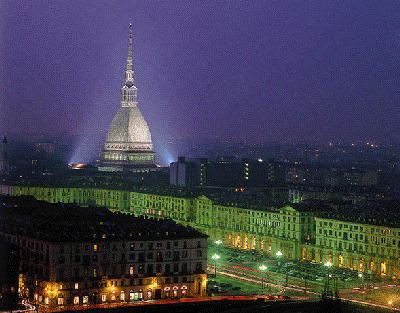|
|
A tribute to my city : |
|

|
Excerpt from Windows on Italy - De Agostini
Lying largely on the left bank of the Po River, 239 m. above sea level, at the
confluence of the Sangone, Dora Baltea and Stura di Lanzo, Turin is the great
industrial, commercial and cultural centre round which much of the region's
economy revolves.
Originally the centre of the Galli Taurini, Turin was a Roman municipality
named after Augusta Taurinorum (as is seen from its chess-board layout), and
later capital of a Lombard duchy and a Frankish county. Passing to the Savoys
in 1280, after many vicissitudes, in 1713 it became the capital of the Kingdom
of Sardinia and then, until 1865, of the new Kingdom of Italy.
The city has a wealth of monuments and historical buildings. Among the best
known are the medieval Palazzo Madama, a castle in the 13th and 14th centuries,
with a 1721 facade. During the Baroque period the city gained numerous fine
buildings, as urban reorganization planned by famous architects proceeded.
Palazzo Reale, Castello del Valentino, Villa Reale at Stupinigi, the Superga
basilica, the Gran Madre and Consolata churches and Piazza San Carlo were
designed and built then.
In the 18th century the tall bold Mole, symbol of the city, was created by
Antonelli.
Quote from Giorgio De Chirico, painter, 1939
Turin is a very curious city which international aestethicism hasn't yet recognized as one of the marvels of Beautiful Italy. Even if not madly in love with aesthetic culture, the foreigner arriving on foot, rail or sea, and visiting the land of the orange blossoms, would surely have other destinations: Venice, Florence, and those small towns in Umbria and Tuscany, meccas for lovers of primitivism, purity and spirituality. And yet Turin is the most profound, enigmatic and disturbing city not only in Italy, but in the world.
It was a German philosopher and poet of Polish origin who first discovered the cryptic beauty of Turin: Frederich Nietsche. It was he who first felt the infinite poetry which emanates from this calm and ordered city, constructed on a plain, adorned and characterized by gentle hills, romantic parks, castles and solemn palaces. It extends from the two banks of a river which flows slowly, now grey, then blue, rather like the world flows and the lives of men.
It was Nietsche who first grasped the enigma of those straight roads and streets, bordered by houses standing on porticos, under which even in rainy weather, one can walk peacefully with friends discussing art, philosophy and poetry, sheltered from the rain, or in summer, from the hot rays of the sun, Turin is the city of itinerant friendships. It's there that real friendship are born, those platonic relationships which fill our hearts with pure joy, they give us a premonition of eternity echoed in the melodies of Chopin and the art of Paolo Veronese.
The beauty of Turin is difficult to perceive; so difficult that apart from Nietsche and myself, I don't know of anyone who has considered it up to now. I suspect Count Gobineau had an inkling of this mystery, but unfortunately haven't sufficient evidence to prove this. Turin reveals its beauty little by little, like a good and honest Gorgon, who knows the cost on the beholder if she all at once unveils her face. It is a beauty that can indeed in some cases be fatal. So it was with Frederich Nietsche. His metaphisical discoveries and intellectual adventures precipitated him into a life of violent emotions; thus, weakened, he couldn't resist for long in a total contemplation of the beauty of Turin, and went insane during one of those autumns in which the long shadows, the calm sky, the atmosphere of happines and convalescence is released by nature after the criminal violence of the spring and the debilitating fevers of the summer, elevating the occult beauty of Turin to its highest levels of expression.
Then a whole population of bronze and marble statues, great men that all the year stand motionless atop their low pedestals, in the midst of the hustle and bustle of the city, descend, and after stretching their legs, walk cautiously towards the famous Piazza Castello where they hold mysterious encounters. There, under that pure autumn sky, they come together to sing in chorus the ineffable hymn to eternal fedelity and everlasting friendship. One sees Lagrange, the scientist and thinker, who leans on the solid arm of a man with a grognard moustache, Colonel Missori, who during a battle against the Austrians saved the life of Garibaldi by using his body as a shield and killed three enemy cavalrymen with his long nosed revolver loaded with protruding bullets. One sees Garibaldi himself, the fearless soldier, the bearded lion, with the eyes of a young romantic girl; one listens to the voice of Giuseppe Verdi, low and heavy with emotion, telling how he composed the famous romance that the baritone sings in the second act of "Trovatore il balen del suo sorriso"... One sees King Vittorio Emanuele II in bronze, covered with ribbons, cords, crosses, and medals also in bronze, discussing military strategies with Emanuele Filiberto of Savoy who is leaning on the hilt of his long sword.
And all through the city there is silence, meditation and happiness. From the Wallace fountains in the public squares fresh clear water runs. The clocks at the front of the stations mark the time - two o' clock in the afternoon. The locomotives are at rest, and over the roofs of public office buildings and large shops, the soft and brightly coloured bannes wave gently with the fresh breeze from below, from the bottom of the plain, from the Alps that one can see in the distant and clear horizon, their peaks always covered with snow.